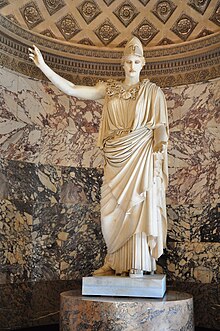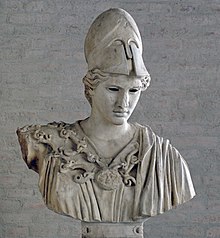Athena of Velletri


TheAthena of VelletriorVelletri Pallasis a type ofclassicalmarblestatueofAthena,wearing ahelmet.
Original
[edit]All statues of this type are 1st centuryRomancopies of a lostGreekbronze,possibly a bronze of c. 430 BC byKresilas.The oval face and the sharpness of the eyebrow ridge, nose and eyes mirror those of the bust of the helmetedPericlesatBritish Museum.[1]That bust is identified with the statue of Pericles that Pliny the Elder (Natural History,XXXIV, 25)[2]attributes to Kresilas and thatPausanias(I, 28, 2) records as sited on the acropolis in the 2nd century. This parallel gives us a date and author for this bronze Athena.
This replaces an old identification of the type's original with thecult statuebyAlcamenesin theTemple of Hephaestuson theAthenian agora.
Plaster casts of the sculpture (probably taken from the original) have been found in excavations of a Roman copyist's workshop atBaiae,and these casts show that Kresilas's bronze was of the same dimensions as the Louvre copy, which is 3.05 metres.
Louvre copy
[edit]Many ancient copies of the bronze have been found (and the Baiae find suggests industrial-scale production of them), but the most famous is the 3.05 m (10 ft) high example found in the ruins of aRoman villain a vineyard nearVelletriin 1797. This example is now in theLouvre,with Accession number is Ma 464 (MR 281). It has traces of red colour in the hair and around the eyes and mouth, a preparatory layer for a fullpolychromaticscheme.
Upon rediscovery, it was purchased byVincenzo Pacetti,who added the peak of the helmet, the straight forearm, the hands, the feet, the snakes, and a section of the cloak, and polished the overall surface. He then sold it to theFrench Directory,which transported it to Rome, where it was soon seized byNeapolitanarmies when they briefly held the city from November to December 1798 during the opening stages of theWar of the Second Coalition.France then regained it in theTreaty of Florence(28 March 1801), and it was displayed at theLouvrefrom December 1803 onwards.
References
[edit]- ^"Marble Portrait Bust of Perikles".British Museum. Archived fromthe originalon 3 October 2015.Retrieved3 October2015.
- ^"LacusCurtius • Pliny the Elder's Natural History — Book 34".
